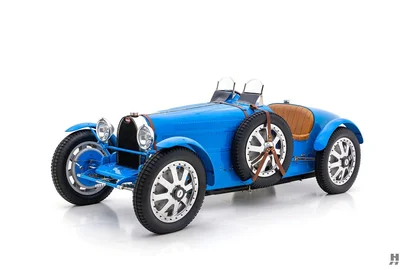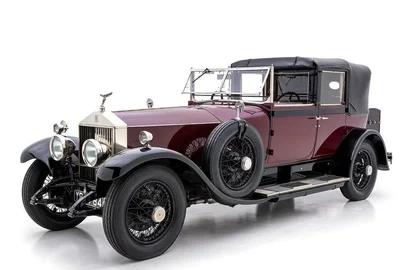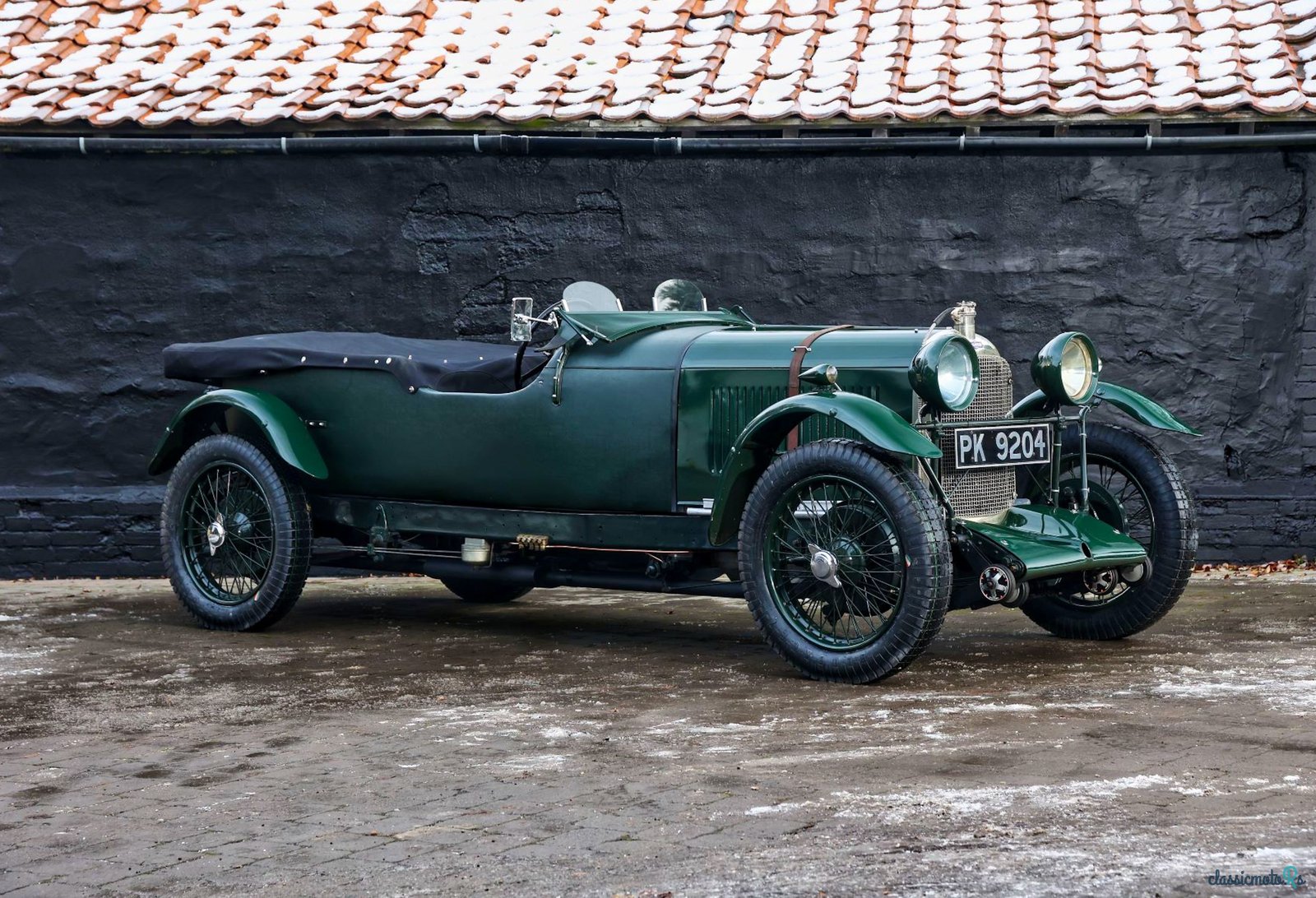
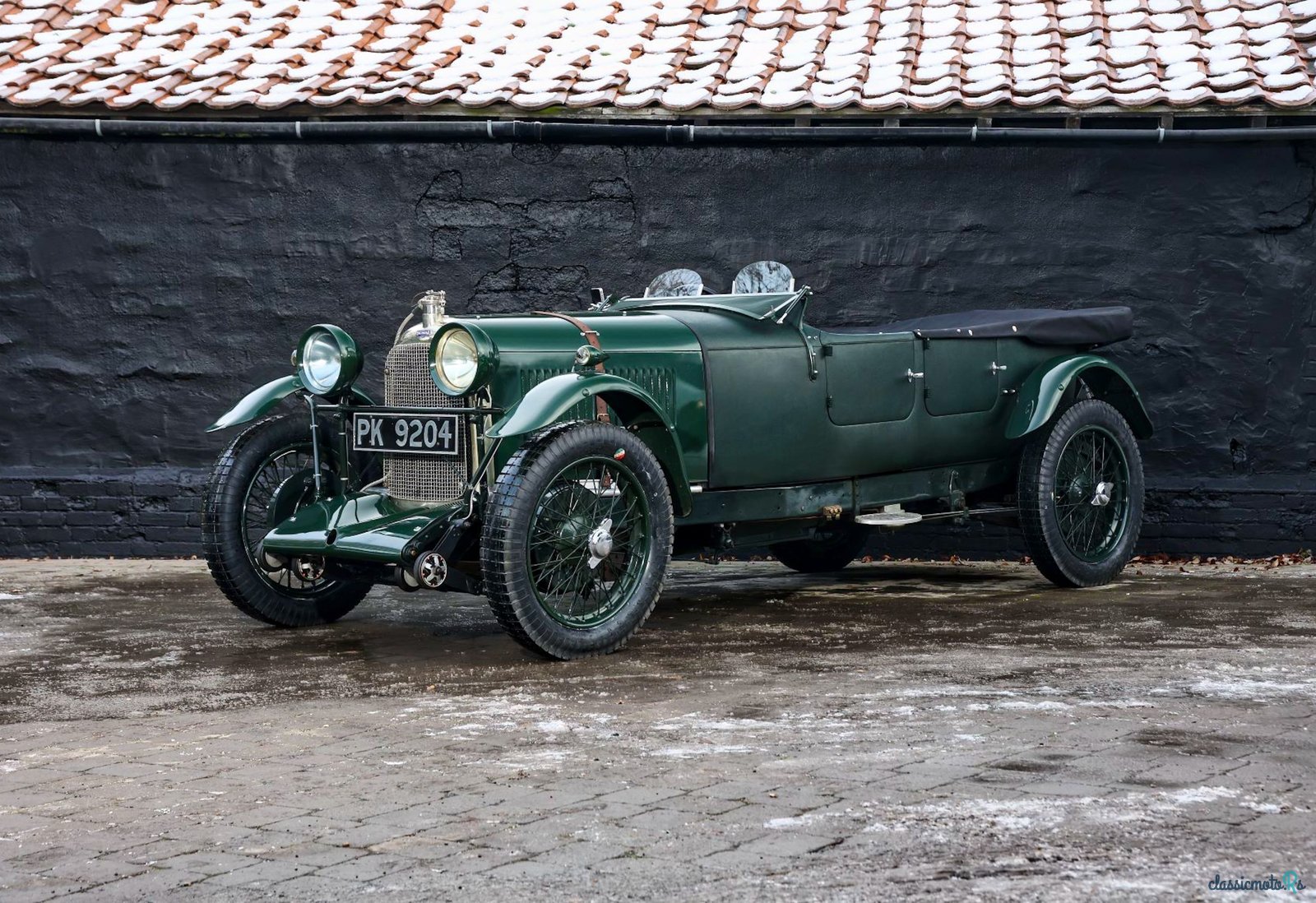
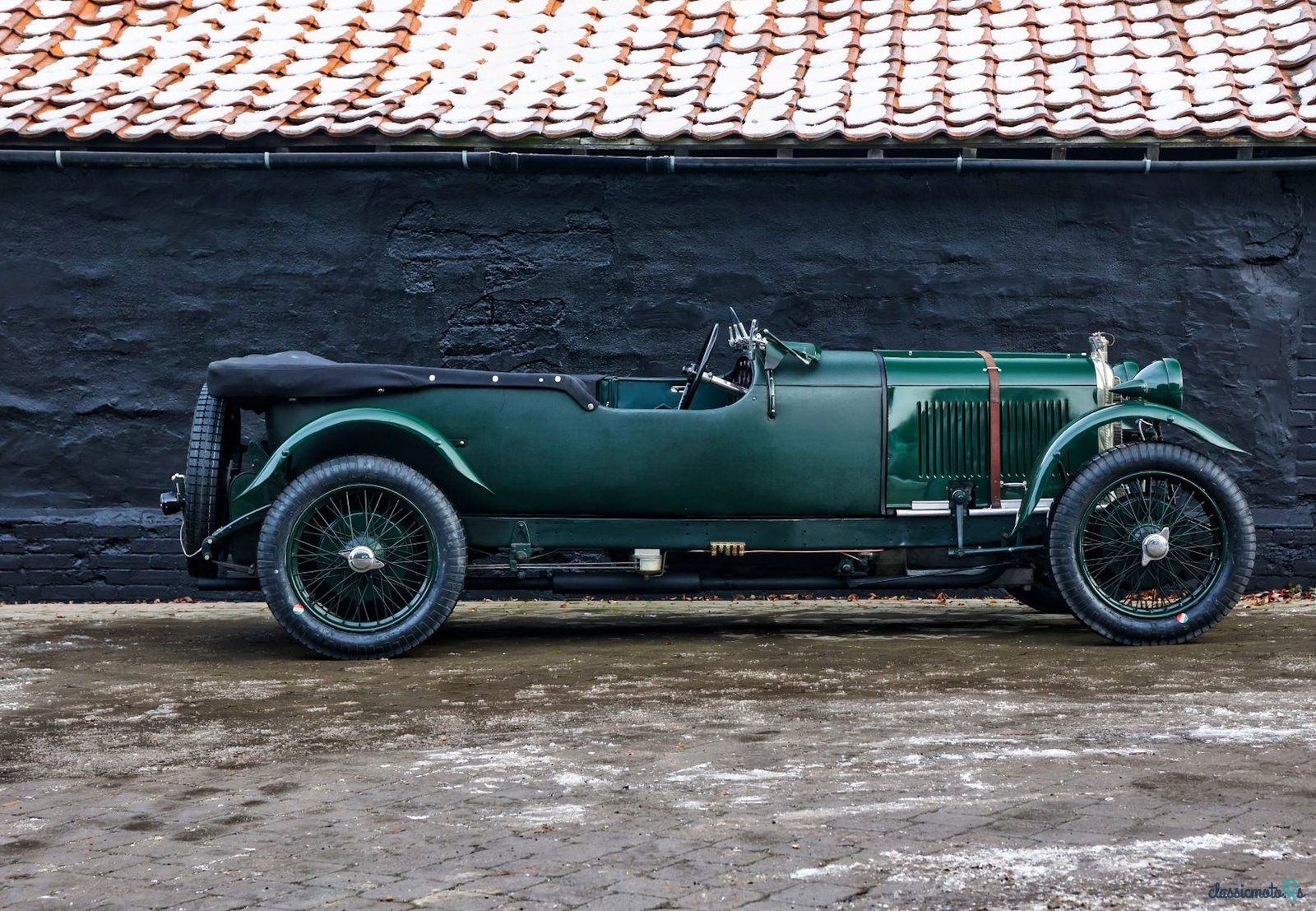
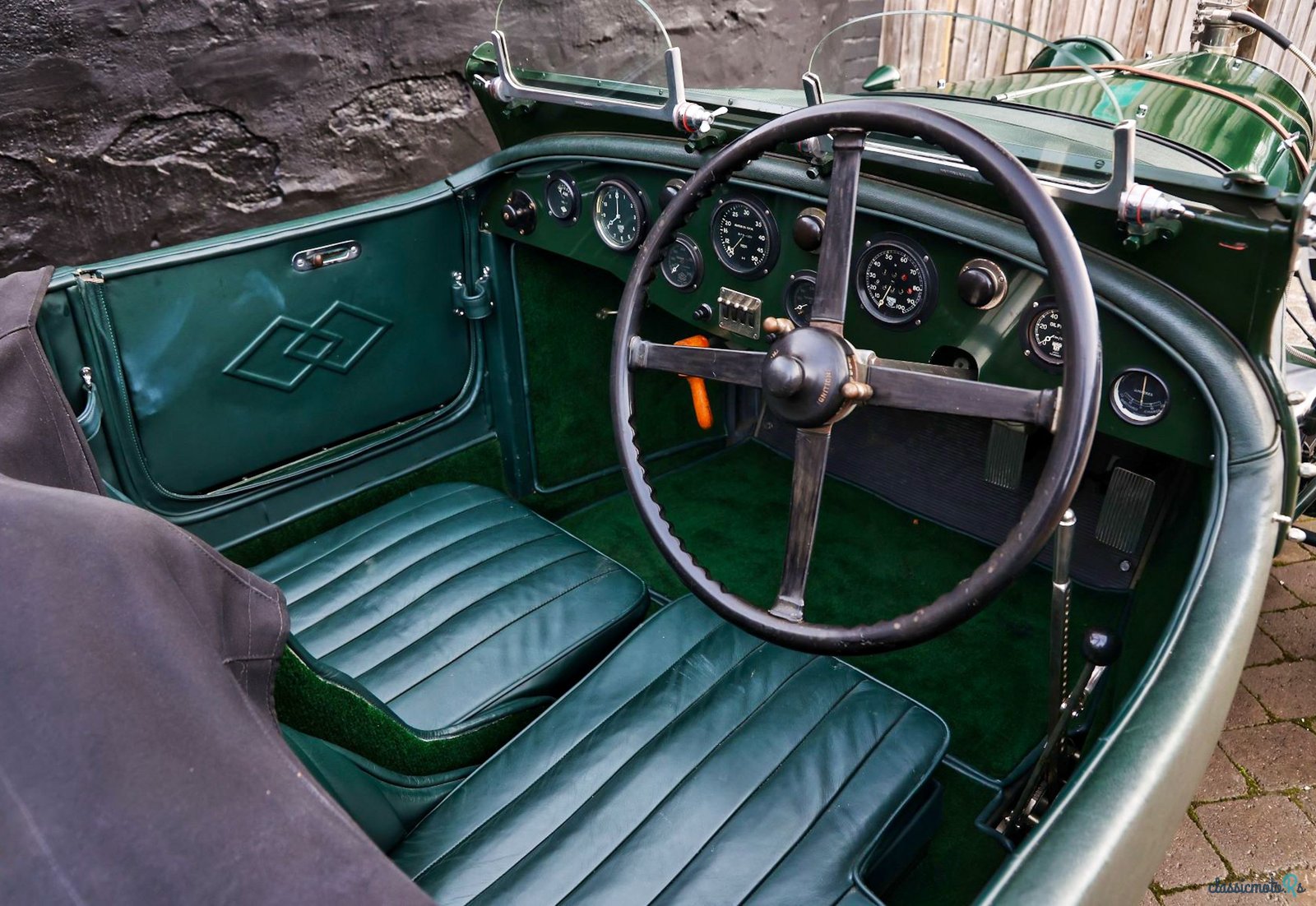
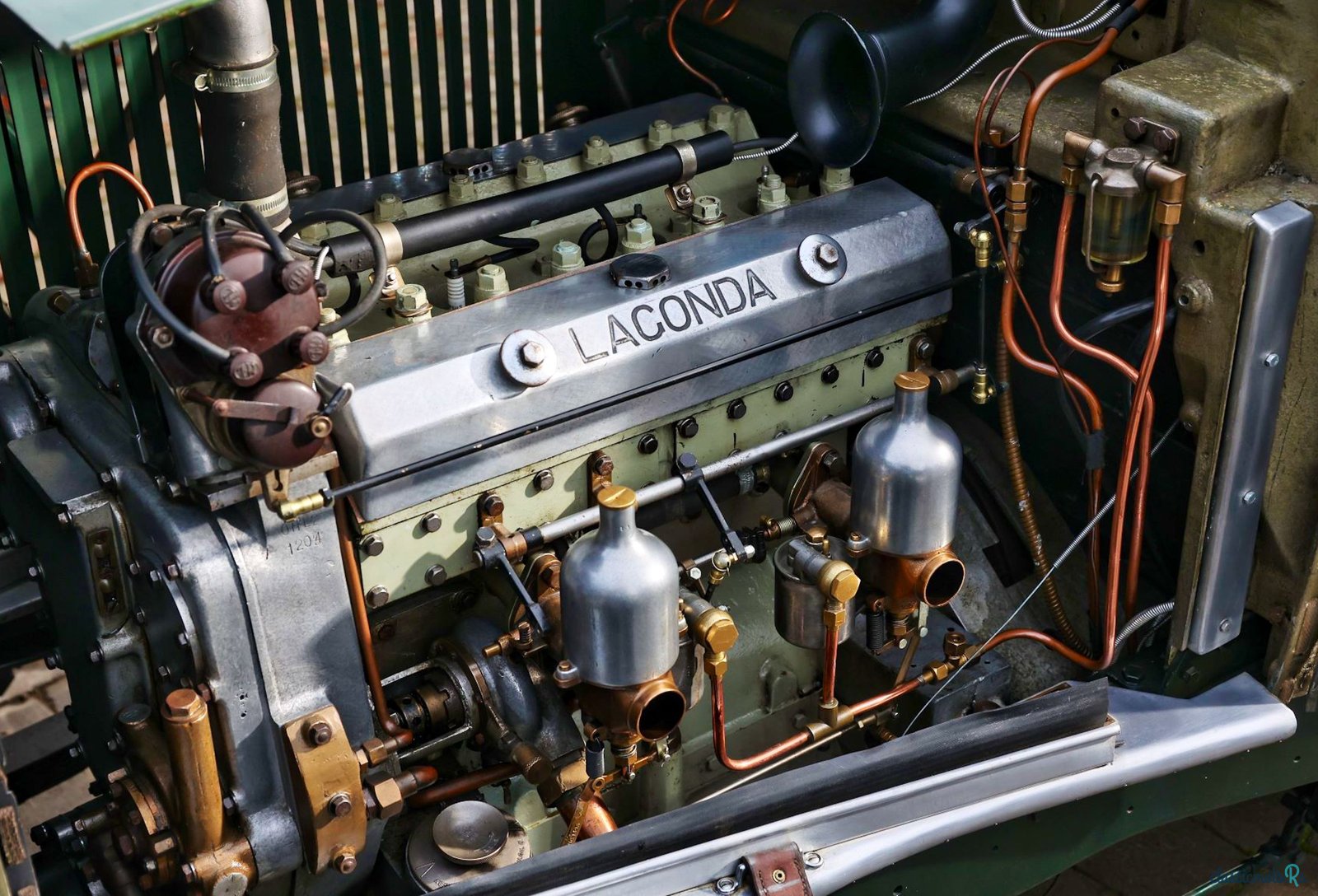
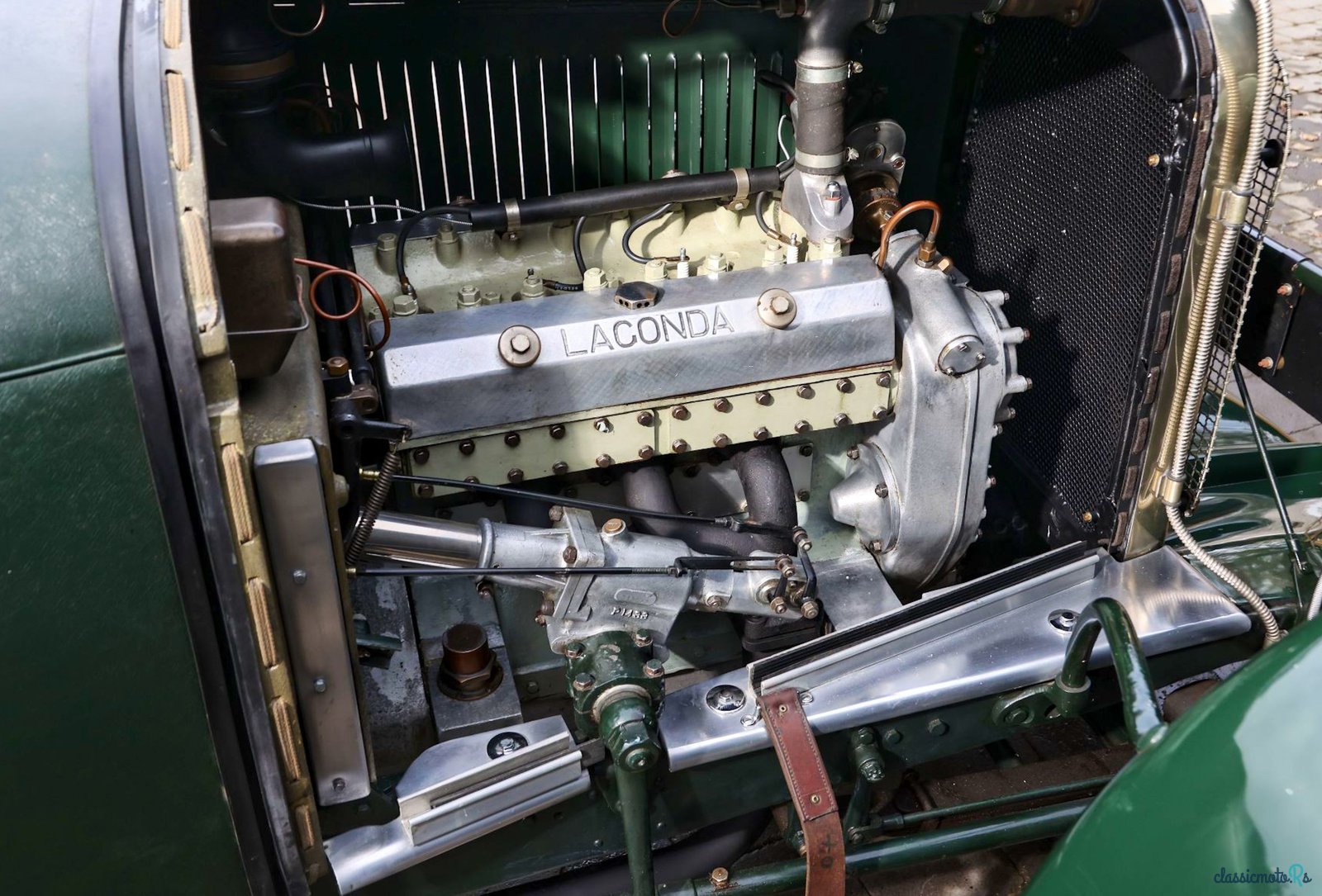
6 photos
1929' Lagonda 2-Litre 'Low Chassis'
Report This Ad!Rate This!Bookmark This
£198,000Published 26 December 2022ID: 33cbcm
Expired
2 years, 11 months ago
2 years, 11 months ago
Information from the owner
Body: Sports Car
Age: 93 years
Exterior color: Green
Exterior: Tonneau Cover
Seller's comments about 1929' Lagonda 2-Litre 'Low Chassis'
Brooklands Double-Twelve, BARC Six-Hours, Irish Grand Prix competitor, Le Mans Classic Eligible
At the end of 1928 a syndicate of Waltham and Hertford, Hertfordshire-based racing enthusiasts decided to pool their resources in order to enter International long-distance sports car racing seriously in 1929. In February 1929 Lagonda agreed to supply the syndicate with special competition versions of the 2-Litre model, for £350 each - roughly half price - on condition that they would not be resold for less than £600. The syndicate planned to run the cars in the Brooklands Double-Twelve, the Six Hours, the Ulster Tourist Trophy and, possibly, to enter and run one in the Le Mans 24- Hour race.
Lagonda had a paid-for entry at Le Mans and placed it at their new client's disposal. The General also promoted their embryo venture to Shell Oil and KLG Spark Plugs recommending sponsorship. Arthur Fox of the Fox & Nicholl Team had also been campaigning a 2-Litre Lagonda, Fox's own car, and an agreement was reached under which Fox & Nicholl of Tolworth, Surrey, would also prepare the new syndicate's sister Lagondas.
The cars arrived at the Fox & Nicholl works at the end of April 1929 which left little time for them to be prepared properly for the Brooklands Double-Twelve race in mid-May. Four cars were provided in all for the syndicate and for Fox & Nicholl, with the fourth being owned by specialist tuner R. R. ‘Robin’ Jackson (the car offered here). The quartet of 2-Litre cars - were given consecutive UK road registrations, PK 9201, 202, 203 and 204. Amongst them 'PK 9201' and '9202' were to be the syndicate's cars, Fox's was 'PK 9203' and Robin Jackson's 'PK 9204' (offered here). This car was not painted black over white like its sisters, 'PK 9201'-'9203', probably being finished in green or black initially. It was owned and raced by Jackson but managed by Fox.
These cars were prototypes of the low-chassis 2-Litre with a revised front axle and the dynamo mounted on the nose of the crankshaft as on the Lagonda 3-litre and 16/ 65 models. Fox & Nicholl's men were amused when the cars were delivered to them without the spacers required to go between the axle and springs at the rear, which left the cars in low-chassis form up front, and 'high-chassis' at the rear. The spacers in fact only arrived in time for the second practice session of the Double-Twelve at Brooklands - until which point the paddock habitués there were highly intrigued by the Lagondas' peculiar stance...
Arthur Fox was a great detail man in his preparation and he ensured his team drivers practised a special start procedure repeatedly pre-race, which paid off as they were flagged away, leading the field. The early race laps had to be completed with hoods raised, and again Fox's attention to detail equipped the hoods with spring loaded clips to assist in each one's furling and being made secure. The syndicate cars and Fox's entry had a windscreen which could be hinged open and locked near-horizontal as a deflector, presenting less frontal area to the airstream yet deflecting it more efficiently than a simple aero-screen around the driver's head and shoulders. Jackson's 'PK 9204' lacked that feature, using a plain aero screen and wire-mesh stone screen instead, though even this had a clever mechanism to raise and lower it ultra-rapidly.
The cars were in fact lightened and modified in many other subtle ways as detailed in the wonderful Lagonda history by Arnold Davey and Anthony May: "Dan Hagen, who owned 'PK 9204' from 1938 until 1967, wrote in the Lagonda Club magazine, in 1954, how he had extracted from the factory before the war details of the amount of tuning the 1929 team cars' engines had received, in addition to drastic lightening of the chassis and bodywork. The camshafts were lighter and carried quick lift, long-dwell cams, The compression ratio was raised to 7. 45 to 1, inlet ports honed out to 36 mm, lightened flywheel, 'French type' Zenith triple-diffuser carburettors, enlarged radiator with pressurised system, straight cut bevel axle with 4 to 1 ratio."
Mr Davey adds: "I doubt if the car would have been sold to the public with that compression ratio, which required a 40% benzole fuel mix to run without detonation”.
For the 1929 Brooklands Double-12 race, driver pairings were:
'PK 9201' - Tim Rose-Richards/ Cecil Randall
'PK 9202' - Bill Edmondson/ George Roberts
'PK 9203' - Frank King/ Howard Wolfe
'PK 9204' - Robin Jackson/ C. A. Broomhall.
This split 24-Hour race - leaving the gigantic Motor Course quiet overnight to ease the inhabitants of Weybridge's slumbers - proved to be a contest between supercharged Alfa Romeos and the big Bentleys - while the 2-Litre cars above were outrun by the factory's proxy entry of a 2-Litre for Mike Couper, which proved to be their 200-mile record car. Still all five of these 2-Litre cars were running at the end of the first 12-Hour competition, the four low-chassis cars and Couper's high-chassis 'special'.
Starting the cold engines at the start of the second day's racing proved near disaster for the Jackson/ Broomhall car which lost nearly an hour before it could be persuaded to fire. Broken exhausts and silencers then afflicted the Fox cars and the Rose-Richards/ Randall entry broke its crankshaft. An Alfa Romeo finally won, with Couper's high-chassis 'special' 9th overall and winner of the 2-Litre class, with Edmondson/ Roberts 13th overall and class 2nd in 'PK 9202', Jackson/ Broomhall in 'PK 9204' 14th overall, class 3rd - and King/ Wolfe 18th overall and 6th in class in 'PK 9203'.
The syndicate emerged most unhappy about the late entry of Couper in the special Lagonda, and a storm blew up between them and General Metcalfe which took a little time to be resolved amicably. The cars were overhauled at Lagonda's Staines factory, and the syndicate decided to give Le Mans a miss and concentrate upon the Six Hours and the Tourist Trophy, with a possible entry in the Irish GP at Dublin.
In fact Captain Forshaw's subsequent deep researches into the true history of these well-raced Lagondas revealed that it was 'PK 9203' which Arthur Fox entered at Le Mans 1929 to be co-driven by Tim Rose-Richards and the Hon. Brian Lewis (the extremely talented subsequent Alfa Romeo Tipo B driver who would become Lord Essendon).
The Sarthe circuit at Le Mans was shortened for the 1929 24-Hour race with the former hairpin section at Pontlieu being bypassed, which gave the opportunity to fit higher first gear ratios. Fox possibly over-estimated the ratio he chose, and so much time was lost in practice re-gearing the car. The press remarked upon the incredible exhaust note of the 2-Litre Lagonda. Fox's adjustments were sufficient to see 'PK 9203' leading away from the start before it was engulfed by the leading Bentley. After three hours the Lagonda was still only three laps behind the Bentley and running well. But after 283 miles the Lagonda came into the pits with its floorboards charred and beginning to burn. The engine was overheating severely, and a failed head gasket was diagnosed, causing the gallant entry to be retired, since under the regulations cooling water could not be replenished until lap 40, another 12 long 8-mile laps... an unserviceable challenge.
In the BARC Six-Hours at Brooklands, Arthur Fox then entered six Lagondas, two 3-Litres (for Hindmarsh and King) and the four 2-Litres. The driver pairings were:
'PK 9201' - Rose-Richards/ Randall - PERR Syndicate car
'PK 9202' - Roberts/ Pollard - PERR Syndicate car
'PK 9203' - Lewis/ Jervis - Fox's car
'PK 9204' - Jackson/ Broomhall - Jackson's car
Lewis again made a lightning start before settling down to a steady drive. Lewis later slewed off course into a sandbank he lost 15 minutes before he and his mechanic could dig the car out and resume. Rose-Richards/ Randall in '9202' led the team home 9th overall and 4th in the 2-Litre class while Lagonda won the Team Prize and the Mobiloil Cup.
Arthur Fox then entered two 2-Litre cars and a 3-Litre for the Irish GP at Phoenix Park, Dublin, two weeks later, two of them the syndicate cars - 'PK 9203' for Wolfe and 'PK 9204' for Jackson while the 3-Litre, 'PK 9160', was for Hawker test pilot John Hindmarsh. Jackson finished 9th overall, his team-mates being credited as 'finishers' but outside the time limit
One month later, the syndicate despatched 'PK 9202' to the Newtownards circuit in Ireland for Tim Rose-Richards to drive in the RAC Tourist Trophy. Arthur Fox took 'PK 9203' for Hawker Aviation test pilot-cum-racing driver Johnny Hindmarsh to drive. Hindmarsh would finish 3rd in the 2-Litre class behind two Alfa Romeos, while Rose-Richards's car faded after a fast start and he was outside the time limit at race end. At the conclusion of that season the 2-Litre Lagondas were sold on.
Indeed, two original buff UK registration continuation logbooks have survived with ‘PK 9204’, with the car's bodywork colour being recorded as 'Black', the older logbook beginning with a stamp dated October 10, 1935.
The contemporary owner then is listed as Hamish Robert Drummond King . On April 28, 1936 the first change of owner is recorded as being to Rowland Smith Motors Ltd of 78, rapidly followed by their customer - one would assume - Hugh John Burns-Jones, of the RASC (Royal Army Service Corps) Officers' Mess, Woolwich - this change dated May 4, 1936.
Burns-Jones evidently kept the car until August 6, 1938 when it passed to Daniel Roger Hagen. Mr Hagen evidently retained the car during the years of the Second World War, and far beyond, the second buff log book in the related documentation file then recording his payment of road tax upon the vehicle on February 16, 1949. Road tax was paid upon the car in Norfolk in 1960-1962 - after which the next change of owner is to Capt. Ivan Forshaw of Parkstone, Dorset, the transfer being registered on August 2, 1967...
A great enthusiast for the Lagonda marque Captain Forshaw embarked upon a most ambitious project to re-unite all of the Fox and Nicholl Team 1929 Lagondas and restore them, so ‘PK 9204’ had found the best home possible.
All were restored during Captain Forshaw's ownership at Aston Services Dorset and Simon Spenceley - the company's Parts Manager at ASD recalls how that work was undertaken over a period of many years as time and other commitments allowed:
"The restoration of the 2-Litre team cars had already begun when I joined Aston Service Dorset in the summer of 1985. 'PK 9203', always said to be the most original and complete of the cars, had been stripped and the chassis repainted. During the next year or so the other cars were dismantled and assessed, 'PK 9201' being in the best condition of the remaining three, showing signs of having been refurbished at some point and being roadworthy post-war. Those years had been less kind to 'PK 9202' and 'PK 9204' which were both in rather neglected condition mechanically though that was not uncommon for cars of this period.
"The chassis frames were straightened and repaired as necessary with the emphasis on retaining as much of the original metal as possible before hand-painting. As the project progressed all of the chassis components were hand-painted as Captain Forshaw felt this is how they would have been finished when new, the only spray painted parts being the fuel tanks, bonnets, wheels and cycle wings.
"The engines had already been removed from the cars and were being refreshed using as many original Lagonda components as possible. Some of the cast aluminium water pipes and associated components were remanufactured due to severe corrosion but almost everything else was genuine Lagonda. Captain Forshaw had amassed a large inventory of original components by dismantling cars in the post-war years enabling him in most cases to replace severely worn parts with good used items. Wearing parts such as suspension shackle pins were replaced using new components, of course.
"The original components of 'PK 9203' were used as patterns to facilitate production of certain new items which had been lost or which were beyond repair for the other cars. These included new long-range fuel tanks, Le Mans-style filler caps and cycle wings. Three new ash-framed short bodies were produced and I believe that the body for 'PK 9204' was extensively repaired. The axles were overhauled and the springs reset so that the reassembly process could begin. None of the fabricated steel panels fitted to the chassis were serviceable, so new battery boxes and undertrays were manufactured using the originals as patterns.
"During the restoration process great care was taken to use period components where possible, the only modern additions being SU electric fuel pumps and battery isolator switches. All of the cars had their dual shock absorber set-ups reinstated as some had been removed by previous owners to improve ride quality.
Acquired by the current owner directly from the Forshaw family. A great enthusiast for British competition sports cars of the highest quality, he purchased ‘PK 9204’ with the intention of competing in such events as the Flying Scotsman and Le Mans Classic. With this in mind the car was dispatched to Lagonda Specialist Bishop Gray to be checked over, see bills on file for work totalling circa £8, 000, including radiator re-core, fitment of SU carburettors in pace of the Zeniths (offered with the car). At the same time a new set of Blockley tyres were fitted, the tonneau cover was re-made and the front seats re-stuffed by Mike Thomas.
Only offered for sale due to the owners’ commitments not allowing him to use the car as intended ‘PK 9204’ is a true piece of history a survivor from the most romantic era of long-distance sports car racing, manufactured by one of the most illustrious of British sportscar makers and run by the most famed and respected of British racing teams of the period. ‘PK 9204’ is eligible for the world greatest historic motoring events such as Goodwood, Le Mans Classic and the Flying Scotsman and must represent the most affordable opportunity possible to acquire a 2-Litre, inter-War, sports racing thoroughbred with period International racing history.
At the end of 1928 a syndicate of Waltham and Hertford, Hertfordshire-based racing enthusiasts decided to pool their resources in order to enter International long-distance sports car racing seriously in 1929. In February 1929 Lagonda agreed to supply the syndicate with special competition versions of the 2-Litre model, for £350 each - roughly half price - on condition that they would not be resold for less than £600. The syndicate planned to run the cars in the Brooklands Double-Twelve, the Six Hours, the Ulster Tourist Trophy and, possibly, to enter and run one in the Le Mans 24- Hour race.
Lagonda had a paid-for entry at Le Mans and placed it at their new client's disposal. The General also promoted their embryo venture to Shell Oil and KLG Spark Plugs recommending sponsorship. Arthur Fox of the Fox & Nicholl Team had also been campaigning a 2-Litre Lagonda, Fox's own car, and an agreement was reached under which Fox & Nicholl of Tolworth, Surrey, would also prepare the new syndicate's sister Lagondas.
The cars arrived at the Fox & Nicholl works at the end of April 1929 which left little time for them to be prepared properly for the Brooklands Double-Twelve race in mid-May. Four cars were provided in all for the syndicate and for Fox & Nicholl, with the fourth being owned by specialist tuner R. R. ‘Robin’ Jackson (the car offered here). The quartet of 2-Litre cars - were given consecutive UK road registrations, PK 9201, 202, 203 and 204. Amongst them 'PK 9201' and '9202' were to be the syndicate's cars, Fox's was 'PK 9203' and Robin Jackson's 'PK 9204' (offered here). This car was not painted black over white like its sisters, 'PK 9201'-'9203', probably being finished in green or black initially. It was owned and raced by Jackson but managed by Fox.
These cars were prototypes of the low-chassis 2-Litre with a revised front axle and the dynamo mounted on the nose of the crankshaft as on the Lagonda 3-litre and 16/ 65 models. Fox & Nicholl's men were amused when the cars were delivered to them without the spacers required to go between the axle and springs at the rear, which left the cars in low-chassis form up front, and 'high-chassis' at the rear. The spacers in fact only arrived in time for the second practice session of the Double-Twelve at Brooklands - until which point the paddock habitués there were highly intrigued by the Lagondas' peculiar stance...
Arthur Fox was a great detail man in his preparation and he ensured his team drivers practised a special start procedure repeatedly pre-race, which paid off as they were flagged away, leading the field. The early race laps had to be completed with hoods raised, and again Fox's attention to detail equipped the hoods with spring loaded clips to assist in each one's furling and being made secure. The syndicate cars and Fox's entry had a windscreen which could be hinged open and locked near-horizontal as a deflector, presenting less frontal area to the airstream yet deflecting it more efficiently than a simple aero-screen around the driver's head and shoulders. Jackson's 'PK 9204' lacked that feature, using a plain aero screen and wire-mesh stone screen instead, though even this had a clever mechanism to raise and lower it ultra-rapidly.
The cars were in fact lightened and modified in many other subtle ways as detailed in the wonderful Lagonda history by Arnold Davey and Anthony May: "Dan Hagen, who owned 'PK 9204' from 1938 until 1967, wrote in the Lagonda Club magazine, in 1954, how he had extracted from the factory before the war details of the amount of tuning the 1929 team cars' engines had received, in addition to drastic lightening of the chassis and bodywork. The camshafts were lighter and carried quick lift, long-dwell cams, The compression ratio was raised to 7. 45 to 1, inlet ports honed out to 36 mm, lightened flywheel, 'French type' Zenith triple-diffuser carburettors, enlarged radiator with pressurised system, straight cut bevel axle with 4 to 1 ratio."
Mr Davey adds: "I doubt if the car would have been sold to the public with that compression ratio, which required a 40% benzole fuel mix to run without detonation”.
For the 1929 Brooklands Double-12 race, driver pairings were:
'PK 9201' - Tim Rose-Richards/ Cecil Randall
'PK 9202' - Bill Edmondson/ George Roberts
'PK 9203' - Frank King/ Howard Wolfe
'PK 9204' - Robin Jackson/ C. A. Broomhall.
This split 24-Hour race - leaving the gigantic Motor Course quiet overnight to ease the inhabitants of Weybridge's slumbers - proved to be a contest between supercharged Alfa Romeos and the big Bentleys - while the 2-Litre cars above were outrun by the factory's proxy entry of a 2-Litre for Mike Couper, which proved to be their 200-mile record car. Still all five of these 2-Litre cars were running at the end of the first 12-Hour competition, the four low-chassis cars and Couper's high-chassis 'special'.
Starting the cold engines at the start of the second day's racing proved near disaster for the Jackson/ Broomhall car which lost nearly an hour before it could be persuaded to fire. Broken exhausts and silencers then afflicted the Fox cars and the Rose-Richards/ Randall entry broke its crankshaft. An Alfa Romeo finally won, with Couper's high-chassis 'special' 9th overall and winner of the 2-Litre class, with Edmondson/ Roberts 13th overall and class 2nd in 'PK 9202', Jackson/ Broomhall in 'PK 9204' 14th overall, class 3rd - and King/ Wolfe 18th overall and 6th in class in 'PK 9203'.
The syndicate emerged most unhappy about the late entry of Couper in the special Lagonda, and a storm blew up between them and General Metcalfe which took a little time to be resolved amicably. The cars were overhauled at Lagonda's Staines factory, and the syndicate decided to give Le Mans a miss and concentrate upon the Six Hours and the Tourist Trophy, with a possible entry in the Irish GP at Dublin.
In fact Captain Forshaw's subsequent deep researches into the true history of these well-raced Lagondas revealed that it was 'PK 9203' which Arthur Fox entered at Le Mans 1929 to be co-driven by Tim Rose-Richards and the Hon. Brian Lewis (the extremely talented subsequent Alfa Romeo Tipo B driver who would become Lord Essendon).
The Sarthe circuit at Le Mans was shortened for the 1929 24-Hour race with the former hairpin section at Pontlieu being bypassed, which gave the opportunity to fit higher first gear ratios. Fox possibly over-estimated the ratio he chose, and so much time was lost in practice re-gearing the car. The press remarked upon the incredible exhaust note of the 2-Litre Lagonda. Fox's adjustments were sufficient to see 'PK 9203' leading away from the start before it was engulfed by the leading Bentley. After three hours the Lagonda was still only three laps behind the Bentley and running well. But after 283 miles the Lagonda came into the pits with its floorboards charred and beginning to burn. The engine was overheating severely, and a failed head gasket was diagnosed, causing the gallant entry to be retired, since under the regulations cooling water could not be replenished until lap 40, another 12 long 8-mile laps... an unserviceable challenge.
In the BARC Six-Hours at Brooklands, Arthur Fox then entered six Lagondas, two 3-Litres (for Hindmarsh and King) and the four 2-Litres. The driver pairings were:
'PK 9201' - Rose-Richards/ Randall - PERR Syndicate car
'PK 9202' - Roberts/ Pollard - PERR Syndicate car
'PK 9203' - Lewis/ Jervis - Fox's car
'PK 9204' - Jackson/ Broomhall - Jackson's car
Lewis again made a lightning start before settling down to a steady drive. Lewis later slewed off course into a sandbank he lost 15 minutes before he and his mechanic could dig the car out and resume. Rose-Richards/ Randall in '9202' led the team home 9th overall and 4th in the 2-Litre class while Lagonda won the Team Prize and the Mobiloil Cup.
Arthur Fox then entered two 2-Litre cars and a 3-Litre for the Irish GP at Phoenix Park, Dublin, two weeks later, two of them the syndicate cars - 'PK 9203' for Wolfe and 'PK 9204' for Jackson while the 3-Litre, 'PK 9160', was for Hawker test pilot John Hindmarsh. Jackson finished 9th overall, his team-mates being credited as 'finishers' but outside the time limit
One month later, the syndicate despatched 'PK 9202' to the Newtownards circuit in Ireland for Tim Rose-Richards to drive in the RAC Tourist Trophy. Arthur Fox took 'PK 9203' for Hawker Aviation test pilot-cum-racing driver Johnny Hindmarsh to drive. Hindmarsh would finish 3rd in the 2-Litre class behind two Alfa Romeos, while Rose-Richards's car faded after a fast start and he was outside the time limit at race end. At the conclusion of that season the 2-Litre Lagondas were sold on.
Indeed, two original buff UK registration continuation logbooks have survived with ‘PK 9204’, with the car's bodywork colour being recorded as 'Black', the older logbook beginning with a stamp dated October 10, 1935.
The contemporary owner then is listed as Hamish Robert Drummond King . On April 28, 1936 the first change of owner is recorded as being to Rowland Smith Motors Ltd of 78, rapidly followed by their customer - one would assume - Hugh John Burns-Jones, of the RASC (Royal Army Service Corps) Officers' Mess, Woolwich - this change dated May 4, 1936.
Burns-Jones evidently kept the car until August 6, 1938 when it passed to Daniel Roger Hagen. Mr Hagen evidently retained the car during the years of the Second World War, and far beyond, the second buff log book in the related documentation file then recording his payment of road tax upon the vehicle on February 16, 1949. Road tax was paid upon the car in Norfolk in 1960-1962 - after which the next change of owner is to Capt. Ivan Forshaw of Parkstone, Dorset, the transfer being registered on August 2, 1967...
A great enthusiast for the Lagonda marque Captain Forshaw embarked upon a most ambitious project to re-unite all of the Fox and Nicholl Team 1929 Lagondas and restore them, so ‘PK 9204’ had found the best home possible.
All were restored during Captain Forshaw's ownership at Aston Services Dorset and Simon Spenceley - the company's Parts Manager at ASD recalls how that work was undertaken over a period of many years as time and other commitments allowed:
"The restoration of the 2-Litre team cars had already begun when I joined Aston Service Dorset in the summer of 1985. 'PK 9203', always said to be the most original and complete of the cars, had been stripped and the chassis repainted. During the next year or so the other cars were dismantled and assessed, 'PK 9201' being in the best condition of the remaining three, showing signs of having been refurbished at some point and being roadworthy post-war. Those years had been less kind to 'PK 9202' and 'PK 9204' which were both in rather neglected condition mechanically though that was not uncommon for cars of this period.
"The chassis frames were straightened and repaired as necessary with the emphasis on retaining as much of the original metal as possible before hand-painting. As the project progressed all of the chassis components were hand-painted as Captain Forshaw felt this is how they would have been finished when new, the only spray painted parts being the fuel tanks, bonnets, wheels and cycle wings.
"The engines had already been removed from the cars and were being refreshed using as many original Lagonda components as possible. Some of the cast aluminium water pipes and associated components were remanufactured due to severe corrosion but almost everything else was genuine Lagonda. Captain Forshaw had amassed a large inventory of original components by dismantling cars in the post-war years enabling him in most cases to replace severely worn parts with good used items. Wearing parts such as suspension shackle pins were replaced using new components, of course.
"The original components of 'PK 9203' were used as patterns to facilitate production of certain new items which had been lost or which were beyond repair for the other cars. These included new long-range fuel tanks, Le Mans-style filler caps and cycle wings. Three new ash-framed short bodies were produced and I believe that the body for 'PK 9204' was extensively repaired. The axles were overhauled and the springs reset so that the reassembly process could begin. None of the fabricated steel panels fitted to the chassis were serviceable, so new battery boxes and undertrays were manufactured using the originals as patterns.
"During the restoration process great care was taken to use period components where possible, the only modern additions being SU electric fuel pumps and battery isolator switches. All of the cars had their dual shock absorber set-ups reinstated as some had been removed by previous owners to improve ride quality.
Acquired by the current owner directly from the Forshaw family. A great enthusiast for British competition sports cars of the highest quality, he purchased ‘PK 9204’ with the intention of competing in such events as the Flying Scotsman and Le Mans Classic. With this in mind the car was dispatched to Lagonda Specialist Bishop Gray to be checked over, see bills on file for work totalling circa £8, 000, including radiator re-core, fitment of SU carburettors in pace of the Zeniths (offered with the car). At the same time a new set of Blockley tyres were fitted, the tonneau cover was re-made and the front seats re-stuffed by Mike Thomas.
Only offered for sale due to the owners’ commitments not allowing him to use the car as intended ‘PK 9204’ is a true piece of history a survivor from the most romantic era of long-distance sports car racing, manufactured by one of the most illustrious of British sportscar makers and run by the most famed and respected of British racing teams of the period. ‘PK 9204’ is eligible for the world greatest historic motoring events such as Goodwood, Le Mans Classic and the Flying Scotsman and must represent the most affordable opportunity possible to acquire a 2-Litre, inter-War, sports racing thoroughbred with period International racing history.
